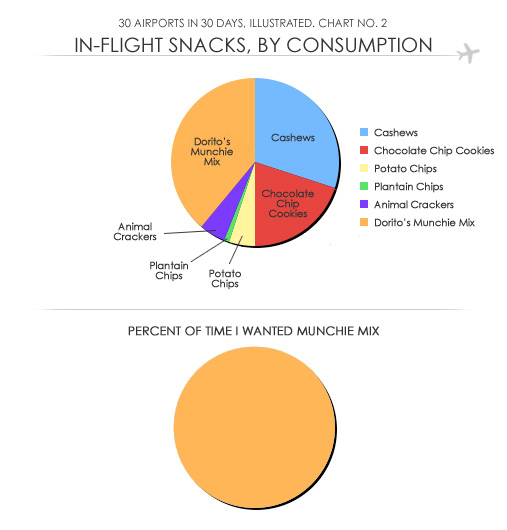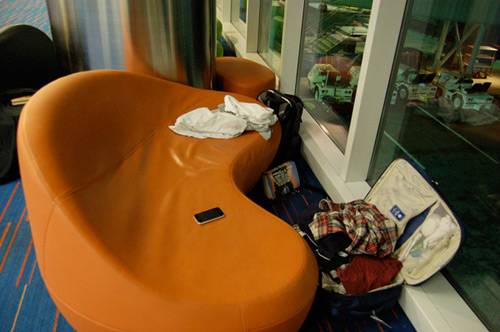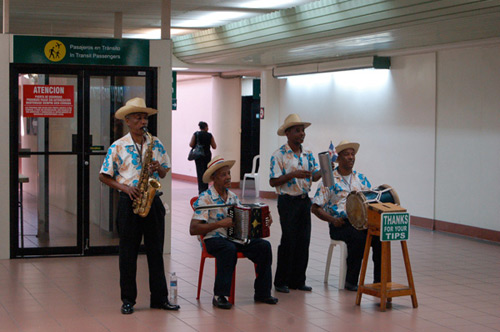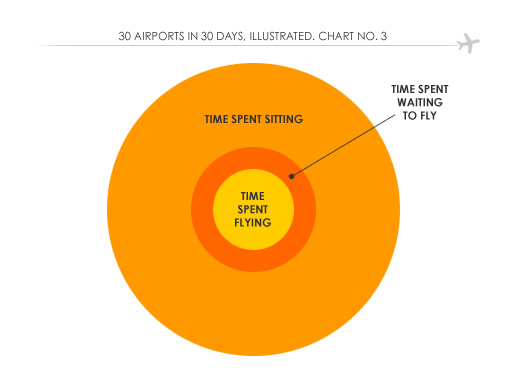30 Airports in 30 Days
Raleigh, N.C., to Fort Lauderdale, Fla., to Richmond, Va., to JFK to Puerto Plata, Dominican Republic, to JFK to San Francisco; Oakland, Calif., to JFK to Boston
There are two questions that friends/acquaintances/the tipsy people I meet in airport bars ask after they find out I'm in the middle of a pilgrimage to nowhere in particular. 1) What's your favorite airport? (Las Vegas! Slot machines in the terminals! Showgirls welcoming you at baggage claim! Lockers that charge one-quarter of what they claim they will!) 2) Is the food as awful as I imagine?
The food is as awful as you imagine.
Nowhere is this more evident than at Fort Lauderdale-Hollywood International Airport. I touch down at 11:30 a.m. with only an hour before my next flight, to Richmond, Va. The only way I can get to 30 airports in 30 days is if the trip features many of these quickies. Arrive; glean shallow insights about a city's demographics, culture, and cuisine; and depart soon thereafter.
An experienced airport gourmand understands that airport food should not be judged by the same criteria as actual food. While his restaurant-trawling friends have the luxury to value flavor, presentation, and service, the airport foodie has a more urgent criterion: Will this give me a stomach ache? Or, to put it more scatologically: Will this force me to use the bathroom midflight? Anything that doesn't is a success.
But, as I discovered in Fort Lauderdale, a qualified success. Because bad food is still bad. Before this trip I would not have believed that "Floribbean cuisine" was a real thing that actually exists. And yet, in Fort Lauderdale—and on Wikipedia!—it is. From what I can tell, it's basically an excuse to toss some plantains, yucca, and coconut in with American food. As you can imagine, this is not promising.
My options:
1) Porky's, a Floribbean Cuban/BBQ/sandwich/salad place. The BBQ and Cuban is wrapped in tin foil, which violates Airport Cuisine Rule No. 23: With premade food, if you can't look, don't touch. The sandwiches appear moderately safe, though it looks as though they're only now thawing from their cryogenic treatment. Best option: Cubed, creamy chicken on a black-bean tortilla wrap.
2) Chef Allen's 2Go, a kiosk in the middle of the gate area. Chef Allen, taking his own advice, is not present at the counter. It is not immediately clear who Chef Allen is nor why he cannot spell. But it is evident he likes to sell sandwiches with far too many condiments. Best option: Jerk chicken on a ciabatta, smothered in something called mango ketchup.
3) Chili's Too, another kiosk opposite Chef Allen's and just as bleak. Why does Chili's, an underrated restaurant but one with little reputation to lose, need a separate brand for its airport express service? Best option: Southwestern turkey sandwich on an onion ciabatta, with cilantro pesto and pepper jack cheese.
The specialty ingredients are, I suppose, aimed at making me buy the sandwiches. Black-bean tortilla wraps! Mango ketchup! Cilantro pesto! How exotic! How … Floribbean! Unfortunately, they're still airport-food flavors. And as I discover when I choose the cilantro pesto, cheap exoticism tastes remarkably American.
In my first bite of the turkey sandwich, all I taste is cold. Why premade airport sandwiches need to be refrigerated like they're human organs is unclear. (I asked Chili's; they just told me they refrigerate it to health standards.) They're kept so cold that the flavors evaporate, and you're left with a sandwich that has more in common with dry ice than with a BLT. This, unlike the fact that the bread tastes like cat litter, is fixable. Airport restaurateurs of America: Turn up the temp on those refrigeration kiosks. It will make you more profitable. Promise.
Bereft of alternatives, I finish the sandwich anyway. By the time we land in Richmond, a few hours later, I haven't reached for the air-sickness bag. Victory.


A question for the crowd: When you're sleeping in a brightly lit room filled with dozens of strangers, do you put on pajamas?
I ask because I'm back in JFK, it's 10:30 p.m., and I need to go to sleep. In the airport.
My final flight of the day arrived at 8 p.m., and my first flight tomorrow is at 7 a.m. Commuting two hours to Brooklyn only to come back to JFK seven hours later (and spending another two hours getting there), is too much, even for a masochistic boob like me. So, I'll suffer another way: by sleeping in the cold fluorescence of an airport terminal.
After a couple of beers to weigh down my eyelids, I walk into the men's room. Airport bathrooms, like most places where strangers come together to share bodily functions, are a place of silent judgment. The smells. The sounds. The hygienic habits. There are few things worse than recognizing your seatmate as the guy who rinsed, but did not wash, his hands.
At night, fellow travelers' sideways glances are even more critical. There are now teeth-brushing, shirt-changing, and face-washing routines to dissect. Such as:
- What's the deal with the hippie who goes into a stall, pulls his ponytail back, changes his outfit, and emerges, now with chest hair in full sight, like a Burt Reynolds impersonator?
- What about that young journalist (yes, the same one who has more or less worn the same outfit for a week) who brazenly stripped off his shirt outside the stalls? What does he think this is, a locker room?
As I brush my teeth, I remember how I felt the first night of college. It's unclear whether I'm inhabiting a new life or a continuation of an old one. I'm uncertain who these people are who keep walking into the bathroom, grunt-nodding in my direction. And I'm unable to foresee a time when this whole thing won't be awkward.
This is not my first airport slumber party. My one other overnight was in Nashville, Tenn., earlier this year, when a buddy and I were on our final night of a college basketball road trip. We had just seen Gwyneth Paltrow at a bluegrass club, eaten a fast-food quesadilla among the revelers at a Qdoba, and needed to be at the airport at 6 in the morning. And so, overly pleased with ourselves, we made our way to the airport, found the warmest section of carpet, and went to sleep.
Four hours later, the televisions across the airport were turned on at maximum volume, we discovered that a dozen people were staring at us from the food court on the other side of the glass. We had fallen asleep in a fishbowl.
At JFK, I was determined to do better. I had two goals. 1) Do not sleep on the floor. 2) Do not sleep where people will stare at you.
At the end of a hallway, I find an oasis that satisfies both. There, JetBlue had placed couches. And there was only one left.

Six hours of shallow, interrupted sleep later, I have some tips for those either interested in or forced into this upper-class homelessness.
1) Invest in earplugs. (It goes without saying that I did not.) The biggest threats to your sleep are TSA warnings, boarding announcements, and screaming children. Find a way to muffle them at all costs.
2) Wrap the softest thing you own over the thickest thing you own. Use it as a pillow. Advanced technique: Bring Velcro straps and fasten the makeshift pillow to the floor/seat/couch.
3) Find a way to wedge your bags between you and a wall. This will not prevent anyone from taking them. (Nor will anyone want to. Airports are among the safest places in the world. Everyone has at least some expendable income, and they've all gone through a metal detector.) But it will offer some peace of mind.
4) The user-generated reviews at Sleepinginairports.net are not nearly as useful as they should be.
5) Don't bother with the pajamas. Jeans are just as comfortable to toss and turn in.

That 7 a.m. flight I spent the night to catch? It's my only trip outside the United States on this quest. We are on our way to Puerto Plata, a city on the north shore of the Dominican Republic. And by "we," I mean me, a lot of demure Dominicans headed home to see their friends and family, and dozens of thirtysomething frat guys with dreams of Caribbean mistresses.
I'm here to see if airports outside the United States are overwhelmingly different than the ones inside. And also to hang out in the tropics for the day.
A merengue band greets me in the arrivals hall with an impromptu washboard and accordion concert. I hang back and listen to them for a bit, but once the wave of passengers passes—and with them, their tips—they stop playing. It's hospitality as tourist trap.

Outside the airport, people are getting their boarding passes. Not at some curbside baggage check, but at the actual check-in desks. Puerto Plata's airport is, well, open-air. Restaurants, a post office, and the waiting area are all out in the humidity. It's part airport, part urban park.
The friend I'm staying with, Laura, lives in Montellano, a small town outside Puerto Plata. There she runs an NGO that provides public health services to Dominicans and Haitians. Basically, what she does makes up for the guy who indulges his monthlong existential crisis. While I'm here, I'm tagging along as she does her job. Laura has a bag filled with a stethoscope and prescription drugs, and we're in pursuit of six of her patients who need check-ups.
She hasn't met these patients before, and finding them is an exercise in guess and check. Addresses here are hit and miss—even if someone writes one down, there aren't street signs or numbers on the houses. As we're on our scavenger hunt, Laura recruits local guides who know the neighborhood and the families who live there. Kids, some of whom have the distended bellies that you see on charity infomercials, start following us, holding my hand and chattering in Spanish. I try to recall the bits and pieces of Spanish that Señora Roos taught me in 12th grade, but all I can think to do is count to tres and lift the kids in the air, like I'm an amusement park ride. Kids, come and ride our newest attraction: El Gringo!
I came to the DR to analyze the airport, but it's far more interesting to analyze its surroundings. Laura's patients are poor; they are not people who find themselves in airports very often. They live in a country where the infrastructure is passable, at best. The plumbing still can't handle toilet paper, the power goes out at random once a day, and the tap water isn't clean. (That hurricanes destroy this infrastructure every decade does not help.) And yet the Dominican Republic's economy is on the upswing—the International Monetary Fund predicts a 5.5 percent growth in its economy this year—largely because of trade and tourism.
Airports have long been promised as economic engines. When the first airfields were being built in the 1920s and '30s, Pan-Am designed air routes to help facilitate trade, shuttling businessmen and mail back and forth between the continents. And these days, no airport makes a decision without an economic development report, so that when the community boards come complaining, they can cite how many jobs they think they'll create.
The day after we make our medical runs, I'm headed back to the airport despite only 24 hours in the DR. I hail a carrito, slang for a sedan that's been turned into a sardine can, and get inside. There are seven of us, three in the front, four in the back, and the 10-minute ride costs 25 pesos (about 67 cents). The driver pulls up to the airport, but I'm not the only one to get out. A woman, a local, leaves, too. She heads toward the check-in counters like me but then veers away toward a booth. There, she climbs in, puts on her uniform, and opens the kiosk for business. I'm here to travel. She's here to work.

Twelve hours later, after a frenzied sprint through customs at JFK and more than 10 hours on two different planes, I am in San Francisco. Or at least, that's what my boarding pass says. After nine straight days of flying, I'm having trouble keeping track of where I am. When I look at maps, I get spasms of nausea, like I want to wake myself from what must be a dream. How could I be in the Dominican Republic one morning and Northern California the next? Back in Las Vegas, I started a habit of involuntarily telling myself the city I had just landed in. "Where am I?" I mutter out loud. "I'm in Las Vegas." "I'm in the Dominican Republic." "I'm in San Francisco." I don't actually feel like I am where I am when I say it. But at least I know where I'm supposed to feel like I am.
Which is to say that the trip has been a success. I wanted to run far enough and for long enough that I felt separated from my old, slightly dysfunctional life. I've done that. Now I have a new, slightly dysfunctional life that's less healthy than the last one. Twenty more days to go!

Ostensibly, I've come to San Francisco to cross two airports off the list, but really I'm just commuting to a lunch date. I'm walking around a lake with my friend Devon, eating fried chicken and talking about old friends, old loves, old people—the same old stuff.
But soon it's time to go. Again. Less than 20 hours after I got to the Bay Area, I'm en route to Oakland's airport. Before I get on the plane, Devon sends me a text message.
It's very odd that now you're just gone. Like, I keep thinking you'll be back in a bit. That you just stepped out or something.
Funny. I feel like I barely stepped in.